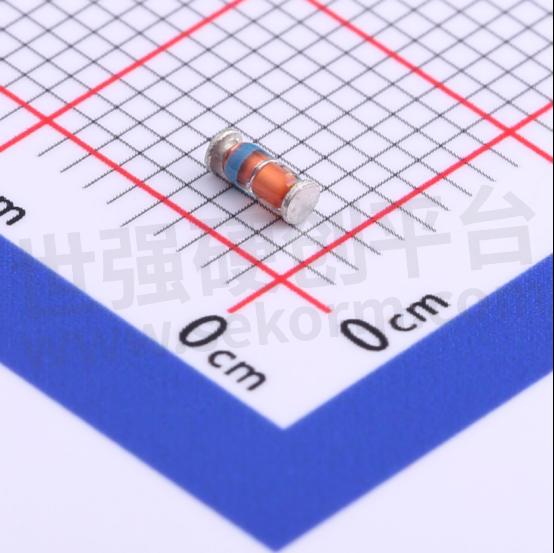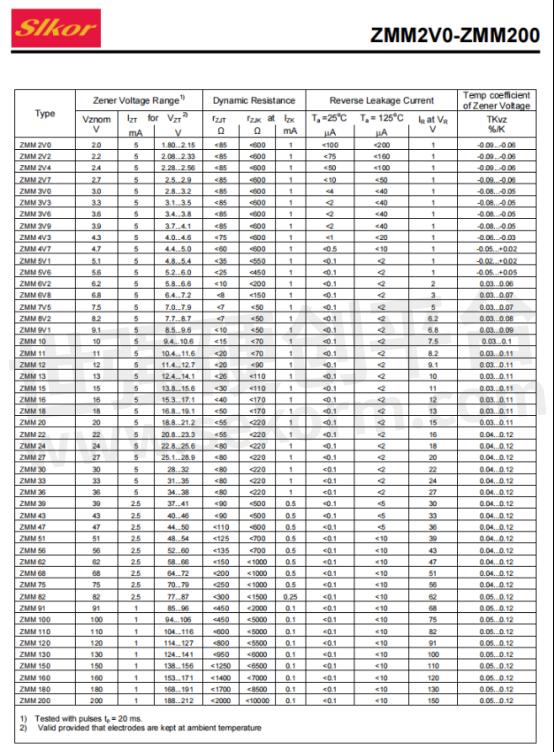ZMM27: High-Voltage Zener Diode for Robust Regulation and Protection, Featuring A VZTyp of 27V, A Power Dissipation Capability of 500mW

The ZMM27 is a high-voltage Zener diode designed to provide robust regulation and protection in electronic circuits operating at elevated voltage levels. Featuring a VZTyp of 27V, a power dissipation (PD) capability of 500mW, and a low reverse leakage current (Ir) of 100nA at 20V, this diode ensures efficient operation and reliable performance in high-voltage applications.

SLKOR Voltage Regulator Diode ZMM27 product photo

Slkor Zener diode ZMM27 specification
Key Points:
High-Voltage Regulation:
VZTyp of 27V allows for effective regulation and protection in circuits requiring stable voltage control at elevated levels.
High Power Dissipation:
Capable of dissipating up to 500mW, making it suitable for applications with significant power requirements.
Low Reverse Leakage Current:
Ir of 100nA at 20V minimizes power loss and enhances efficiency in high-voltage circuits, contributing to prolonged system lifespan.

Parameters of Slkor Zener diode ZMM27
Application Scenarios of ZMM27
The ZMM27 voltage regulator diode is widely used in various electronic devices, especially in circuits that require stable output voltage. For example, in power management circuits, the ZMM27 can ensure stable output voltage, preventing damage to devices caused by voltage fluctuations. Additionally, it can also be used in overvoltage protection circuits for electronic devices to prevent damage from excessively high voltages.
Design Considerations
When using the ZMM27 voltage regulator diode, designers need to pay attention to the following points:
● Ensure that the voltage in the circuit does not exceed the rated voltage of the voltage regulator diode to avoid damaging the diode.
● When designing the circuit, consider the power limit of the diode to ensure it operates within its normal working range.
● When selecting the voltage regulator diode, choose the appropriate model and parameters based on specific application scenarios and requirements.
Selection and Substitution of Voltage Regulator Diodes
The selection and substitution of voltage regulator diodes are common tasks in electronic circuit design and maintenance. Following is a detailed explanation of the selection and substitution process for voltage regulator diodes based on the reference article information:
Selection of Voltage Regulator Diodes
● Principles for parameter matching:
Regulation value: Choose an appropriate regulation value based on specific application requirements. For example, the regulation value of the ZMM27 voltage regulator diode is 27V, with a range of 25.1V to 28.9V.
Rated operating current: Ensure that the selected voltage regulator diode can handle the maximum operating current in the circuit.
Regulation accuracy: For circuits with higher demands, consider the regulation accuracy of the voltage regulator diode.
Dynamic resistance: Choose a voltage regulator diode with a smaller dynamic resistance, as lower dynamic resistance results in better regulation performance.
● Principles for reliable quality:
Choose voltage regulator diodes with reliable quality, such as well-known brands or products with a good reputation, to ensure the stability and longevity of the circuit.
● Principles for application environment:
Consider environmental factors such as temperature, humidity, and vibration when selecting voltage regulator diodes that can adapt to specific application environments.
● Other considerations:
Pay attention to the fact that the reverse current of the voltage regulator diode cannot increase infinitely to prevent overheating damage. Therefore, a series current-limiting resistor may be needed in the circuit.
There is significant variation in the regulation values of voltage regulator diodes. Even for the same model, the stable voltage values may not be exactly the same. Therefore, for circuits with higher demands, the regulation values should be tested before selection.
Substitution of Voltage Regulator Diodes
● Measuring the parameters of the voltage regulator diode:
Use a multimeter or testing instrument to measure the parameters of the original voltage regulator diode, including the regulation voltage, forward voltage, and reverse current.
● Selecting a substitute voltage regulator diode:
Based on the measured parameters, choose a substitute voltage regulator diode with the same or similar parameters as the original one.
● Replacing the voltage regulator diode:
Cut off the power supply, and remove the outer casing of the device to access the aging or damaged voltage regulator diode.
● Carefully remove the original voltage regulator diode from the circuit board, taking care to avoid damaging other electrical components and the circuit board.
● Install the new voltage regulator diode onto the circuit board, ensuring that the pin orientation and position are correct.
● Testing and inspection:
After replacing the voltage regulator diode, reconnect the power supply, start the device, and conduct necessary tests and inspections to ensure that the voltage regulator diode is functioning properly.
- +1 Like
- Add to Favorites
Recommend
This document is provided by Sekorm Platform for VIP exclusive service. The copyright is owned by Sekorm. Without authorization, any medias, websites or individual are not allowed to reprint. When authorizing the reprint, the link of www.sekorm.com must be indicated.


























































































































































































































































































































































































































































































































































































































































































































































































































































































































